Articles
- Page Path
- HOME > J Korean Acad Nurs > Volume 38(5); 2008 > Article
-
Original Article
- The Effects of Psychosocial Rehabilitation Programs on the Levels of Self-Efficacy for Mentally Disabled Persons
- Hyun Sook Park, Sung-Woo Bae, Yi Young Kim
-
Journal of Korean Academy of Nursing 2008;38(5):704-711.
DOI: https://doi.org/10.4040/jkan.2008.38.5.704
Published online: October 30, 2008
1Professor, Department of Nursing, Catholic University of Daegu, Daegu, Korea.
2Assistant Professor, Department of Social Welfare, Kyungpook National University, Daegu, Korea.
3Director, Daegu Psychiatric Rehabilitation Center, Daegu, Korea.
- Address reprint requests to: Park, Hyun Sook. Department of Nursing, Catholic University of Daegu, 3056-6 Daemyeong 4-dong, Nam-gu, Daegu 705-718, Korea. Tel: 82-53-650-4827, Fax: 82-53-621-4106, parkhs@cu.ac.kr
• Received: June 24, 2008 • Accepted: October 6, 2008
Copyright © 2008 Korean Society of Nursing Science
Abstract
-
Purpose
- This study investigated the effects of psychosocial rehabilitation programs provided by a psychosocial rehabilitation center on the levels of self-efficacy for mentally disabled persons. We followed the study subjects for 2 yr in order to examine whether the psychosocial rehabilitation programs had a positive impact on their levels of self-efficacy.
-
Methods
- There were 18 subjects in the experimental group and they received all the psychosocial rehabilitation services available at the psychosocial rehabilitation center for 2 yr. In the comparison group, there were 17 participants who voluntarily refused to participate in the psychosocial rehabilitation programs.
-
Results
- The results indicated that the psychosocial rehabilitation programs were effective in increasing the levels of the self-efficacy total score and specific self-efficacy score.
-
Conclusion
- The overall study results indicated that psychosocial rehabilitation programs provided by a psychosocial rehabilitation center had a positive impact on increasing the levels of self-efficacy for mentally disabled persons.
- 1. Bae HS, Lee EJ. The efficacy of stress management education program for the persons with mental disorder. Korean Community Mental Health Journal. 2005;8:129–148.
- 2. Bae SW. Ethnicity and treatment outcomes from community-based psychosocial rehabilitation interventions: A longitudinal and multi-dimensional approach. 2001;Los Angeles, USA, University of Southern California. Unpublished doctoral dissertation.
- 3. Bae SW, Kim YY. Longitudinal examination of the effects of community mental health services provided by a psychosocial rehabilitation center on the quality of life outcomes for the mentally ill. Mental Health and Social Work. 2005;20:69–94.
- 4. Bandura A, Wood R. Effect of perceived controllability and performance standards on self-regulation of complex decision making. Journal of Personality and Social Psychology. 1989;56:805–814.ArticlePubMed
- 5. Bracke P. Measuring the subjective well-being of people in a psychosocial rehabilitation center and a residential psychiatric setting: The outline of the study and the measurement properties of a multidimensional indicator of well-being. Psychiatric Rehabilitation Journal. 2001;24:222–236.ArticlePubMed
- 6. Brekke JS, Ansel M, Long J, Slade E, Weinstein M. Intensity and continuity of services and functional outcomes in the rehabilitation of persons with schizophrenia. Psychiatric Services. 1999;50:248–256.ArticlePubMed
- 7. Brekke JS, Long J. Community-based psychosocial rehabilitation and prospective change in functional, clinical, and subjective experience variables in schizophrenia. Schizophrenia Bulletin. 2000;26:667–680.ArticlePubMed
- 8. Choi BS. The effect of after care program for patients with schizophrenia attending outpatients department. 2001;Gwangju, Chonnam National University. Unpublished master's thesis.
- 9. Clarkin JF, Carpenter D, Hull J, Wilner P, Glick I. Effects of psychoeducational intervention for married patients with bipolar disorder and their spouses. Psychiatric Services. 1998;49:531–533.ArticlePubMed
- 10. Cohen J. Statistical power analysis for the behavioral science. 1988;2nd ed. Hillsdale, NJ, Erlbaum.
- 11. Durbin J, Perndergast P, Dewa CS, Rush B, Cooke RG. Mental health program monitoring: Towards simplifying a complex task. Psychiatric Rehabilitation Journal. 2003;26:249–261.ArticlePubMed
- 12. Eklund M, Hansson L, Bejerholm U. Relationships between satisfaction with occupational factors and health related variables in schizophrenia outpatient. Social Psychiatry and Psychiatric Epidemiology. 2001;36:79–89.ArticlePubMedPDF
- 13. Han KS, Im HS, Yang BK, Chung HK, Suh YJ. Effects of assertive training on interpersonal relations, social behavior, and psychiatric symptoms in patients with a mental disorder. Journal of Korean Academy of Nursing. 2005;35:896–903.ArticlePubMedPDF
- 14. Kang DG. Analysis of motivation for change of the person with psychiatric disabilities and effectiveness of motivation improvement program. 2007;Daegu, Kyungpook National University. Unpublished doctoral dissertation.
- 15. Kang SK. Perception of psychosocial rehabilitation treatment environment and coping behavior: The role of self-efficacy. Mental Health and Social Work. 2007;27:152–175.
- 16. Kim CK, Kwang DH, Cho JS, Shim KS, Ha JS, Byun WT, et al. Effect of psychosocial rehabilitation for schizophrenia at the community welfare center. Mental Health Services. 1997;2:53–67.
- 17. Kim HJ. Effects of prevocational education program for vocational rehabilitation of the person with psychiatric disability. Korean Community Mental Health Journal. 2005;8:151–168.
- 18. Kim YY. The psychiatric rehabilitation services and their impact on rehabilitation outcomes: Six month follow up. Korean Community Mental Health Journal. 2004;6:5–26.
- 19. Kim YY. The efficacy of basis education(medication management, symptom management, stress management, conversation skill training, daily living skill training) for persons with mental disorder. Korean Community Mental Health Journal. 2005;8:91–107.
- 20. Kim YY, Park HS, Park KM. The effects of a recovery education program on rehabilitation motivation, symptoms, and function for schizophrenic patients. Journal of Korean Academy of Nursing. 2006;36:542–550.ArticlePubMedPDF
- 21. Lee KS. Effect of health-oriented social skills training on improvement of communication skills in schizophrenics. Korean Community Mental Health Journal. 2005;8:109–128.
- 22. Park HS, Kim TK, Kim HM, Son KH, Lee HK, Jeon SS, et al. Psychiatric mental health nursing: Contemporary practice. 2008;Seoul, Hyunmoon Co.
- 23. Park SG. Effect of perspective-oriented social skills training on improvement of social skills in schizophrenics. 1999;Daegu, Keimyung University. Unpublished doctoral dissertation.
- 24. Rho ES. A study on the development of the quality of life model of schizophrenic patients. 2000;Seoul, Chungang University. Unpublished doctoral dissertation.
- 25. Rho ES, Kwon HJ, Ryu EJ. A study on self-efficacy and quality of life in schizophrenic patients. Journal of Korean Academy of Nursing. 2001;31:912–920.ArticlePDF
- 26. Robinson D, Woerner M, Schooler N. Intervention research in psychosis: Issues related to clinical assessment. Schizophrenia Bulletin. 2000;26:551–556.ArticlePubMed
- 27. Scott JE, Dixon LB. Psychological interventions for schizophrenia. Schizophrenia Bulletin. 1995;21:621–630.ArticlePubMed
- 28. Seo YM. Meta-analysis of pychosocial rehabilitation programs about schizophrenia patients. 2002;Busan, Kyungsung University. Unpublished master's thesis.
- 29. Yildiz M, Veznedaroglu B, Eryavux A, Kayahan B. Psychosocial skills training on social functioning and quality of life in the treatment of schizophrenia: A controlled study in Turkey. International Journal of Psychiatric in Clinical Practice. 2004;8:219–225.Article
REFERENCES
Figure & Data
REFERENCES
Citations
Citations to this article as recorded by 

- Hope Enhancement Program for Increased Hope, Self-Efficacy, and Quality of Life for Mentally Ill Persons in Day Hospitals
Ju Hyun Park, Hyun Sook Park
Journal of Korean Academy of Psychiatric and Mental Health Nursing.2017; 26(3): 260. CrossRef - The Effects of Cognitive Behavioral Group Therapy Improving Social Cognition on the Self efficacy, Relationship Function and Social Skills for Chronic Schizophrenia
Mi Yeul Hyun
Journal of Korean Academy of Psychiatric and Mental Health Nursing.2017; 26(2): 186. CrossRef - Fifteen-month follow up of an assertive community treatment program for chronic patients with mental illness
Tae-Won Kim, Jong-Hyun Jeong, Young-Hee Kim, Yura Kim, Ho-Jun Seo, Seung-Chul Hong
BMC Health Services Research.2015;[Epub] CrossRef - The Effects of a Self-esteem Improvement Program on Self-esteem, Depression, and Interpersonal Relationships in Community Dwelling Patients with Chronic Schizophrenia
Jung Sug Kim, Young Mi Lim
Journal of Korean Academy of Psychiatric and Mental Health Nursing.2010; 19(4): 420. CrossRef - The Effects of Insight and Empowerment on Function and Quality of Life for Patients with Schizophrenia.
Yi Young Kim, Hyun Sook Park
Journal of Korean Academy of psychiatric and Mental Health Nursing.2010; 19(1): 11. CrossRef
The Effects of Psychosocial Rehabilitation Programs on the Levels of Self-Efficacy for Mentally Disabled Persons
The Effects of Psychosocial Rehabilitation Programs on the Levels of Self-Efficacy for Mentally Disabled Persons
Overview of the Psychosocial Rehabilitation Programs
Homogeneity Test for General Characteristics (N=35)
Homogeneity Test for Self-Efficacy (N=35)
Analysis of Self-Efficacy according to Treatment (N=35)
Analysis of Specific Self-Efficacy according to Treatment (N=35)
Analysis of General Self-Efficacy according to Treatment (N=35)
Table 1
Overview of the Psychosocial Rehabilitation Programs
Table 2
Homogeneity Test for General Characteristics (N=35)
Table 3
Homogeneity Test for Self-Efficacy (N=35)
Table 4
Analysis of Self-Efficacy according to Treatment (N=35)
Table 5
Analysis of Specific Self-Efficacy according to Treatment (N=35)
Table 6
Analysis of General Self-Efficacy according to Treatment (N=35)
 KSNS
KSNS
 E-SUBMISSION
E-SUBMISSION
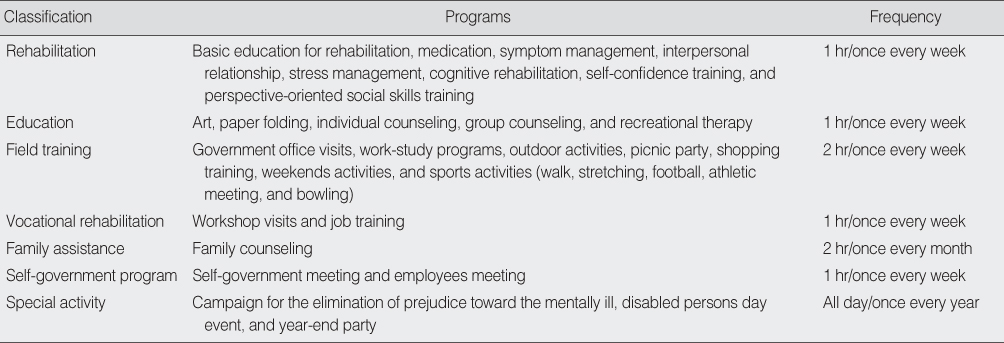
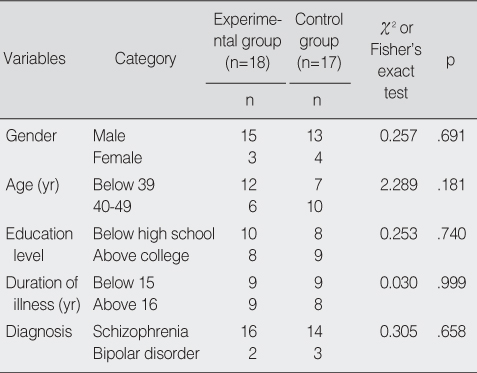
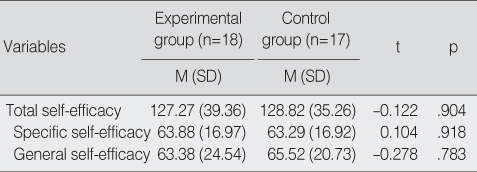
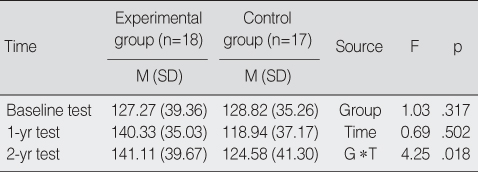
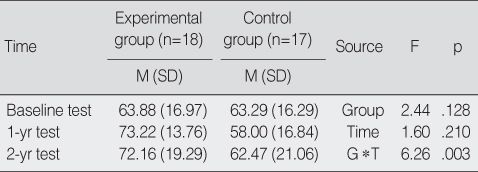
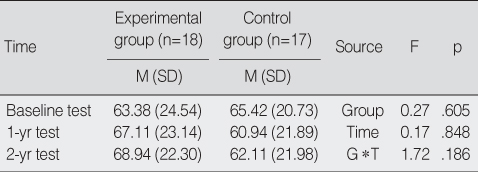
 Cite
Cite

